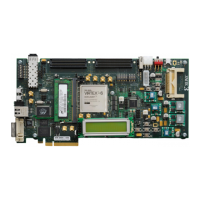
Do you have a question about the Xilinx Virtex-6 FPGA and is the answer not in the manual?
| Technology | 40nm |
|---|---|
| Clock Data Recovery (CDR) | Integrated |
| Logic Cells | Up to 760, 000 |
| I/O Pins | Up to 1200 |
| Transceiver Features | Pre-emphasis, equalization |
| Transceiver Protocol Support | PCIe, SATA, Ethernet, CPRI, OBSAI, Serial RapidIO |
| Power Consumption | Varies by model and configuration |
| Transceiver Type | Multi-Gigabit Transceivers (RocketIO GTP/GTX) |
Lists the chapters and appendices included in this manual.
Provides links to other Xilinx documents for further information.
Introduces the Virtex-6 FPGA GTX transceiver and its features.
Summarizes GTX ports and attributes, grouped by functionality.
Explains prerequisites and setup for simulating GTX transceiver designs.
Details mapping GTX transceivers to device resources and UCF creation.
Describes the structure and ports for reference clock inputs.
Explains how to select and route reference clocks for GTX transceivers.
Details the Phase-Locked Loop (PLL) architecture and its settings.
Describes the various power-down modes and capabilities of the GTX transceiver.
Explains loopback modes for testing the transceiver datapath.
Covers the ACJTAG interface support for GTX transceivers.
Explains the DRP for dynamic parameter changes in GTXE1 primitive.
Introduces the functional blocks and key elements of the GTX transmitter.
Describes the gateway for transmitting data to the GTX transceiver.
Details the procedures for resetting and initializing the GTX TX.
Explains the 8B/10B encoding scheme used for outgoing data.
Describes support for 64B/66B and 64B/67B encoding for high-speed protocols.
Explains the TX buffer's role in resolving phase differences between domains.
Covers the advanced feature of bypassing the TX buffer for reduced latency.
Details the PRBS and other patterns for testing signal integrity.
Explains the built-in 5X oversampling feature for serial rates.
Describes the function to invert outgoing data polarity before transmission.
Details the serial and parallel clock divider control for TX fabric clocks.
Explains the high-speed current-mode differential output buffer features.
Describes the feature for detecting receiver presence on a link.
Covers support for SATA/SAS OOB sequences and PCI Express beaconing.
Introduces the functional blocks and key elements of the GTX receiver.
Describes the high-speed current-mode input differential buffer.
Covers support for decoding SATA/SAS OOB sequences and PCI Express beacons.
Explains the circuit for compensating high-frequency losses in the channel.
Details the Clock Data Recovery circuit for extracting clock and data.
Covers serial and parallel clock divider control for RX fabric clocks.
Discusses methods for determining link quality via eye diagrams.
Describes the function to invert incoming data polarity.
Explains the built-in 5X oversampling for low serial rates.
Details the built-in PRBS checker for testing channel signal integrity.
Explains the process of aligning serial data to byte boundaries.
Describes the state machine for detecting channel malfunction.
Explains the decoder for RX data, indicating errors and control sequences.
Covers the advanced feature of bypassing the RX elastic buffer for low latency.
Explains the buffer for resolving clock domain differences.
Details the circuit for tolerating frequency differences between clock domains.
Describes using the RX elastic buffer to cancel skew between lanes.
Describes support for 64B/66B and 64B/67B encoding for high-speed protocols.
Details the procedures for resetting and initializing the GTX RX.
Describes the interface for receiving RX data from the GTX RX.
Discusses implementing GTX transceivers on a PCB for optimal performance.
Describes GTX transceiver pins and provides design guidelines.
Explains the circuit for calibrating termination resistors.
Details the MGTAVCC and MGTAVTT analog power supply pins.
Focuses on the selection criteria for reference clock sources.
Discusses issues regarding power supply implementation on the PCB.
Explains how crosstalk degrades GTX transceiver performance and how to avoid it.
Provides guidelines for SelectIO interface usage to minimize GTX impact.